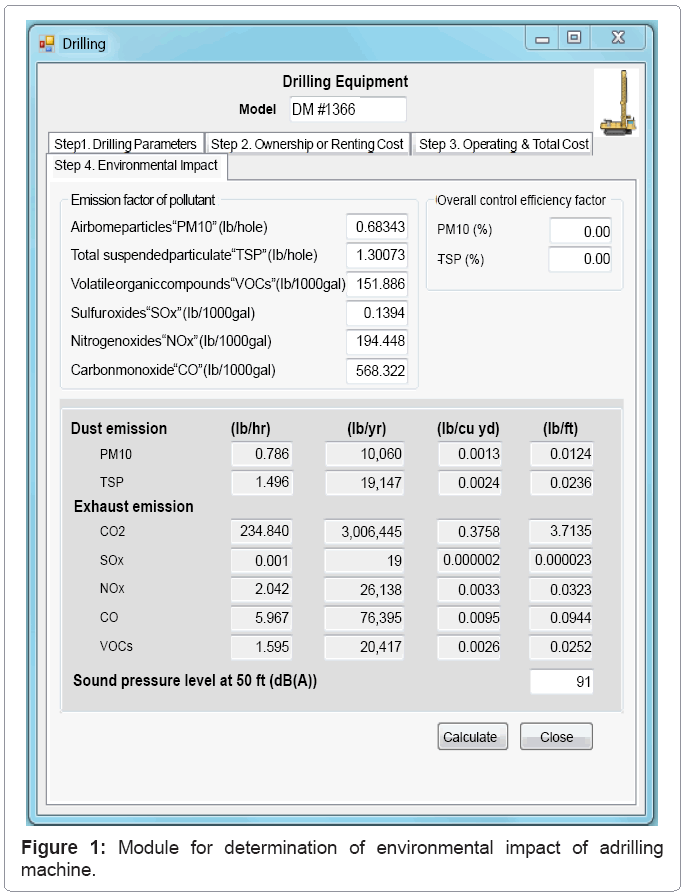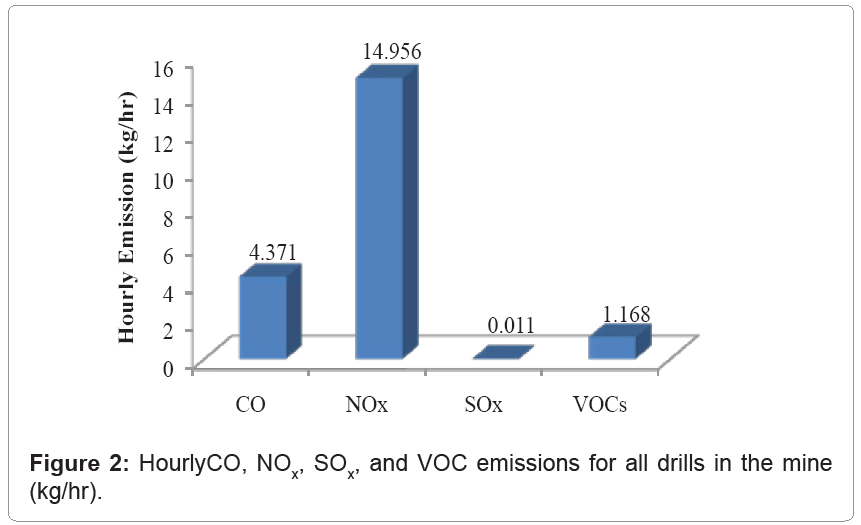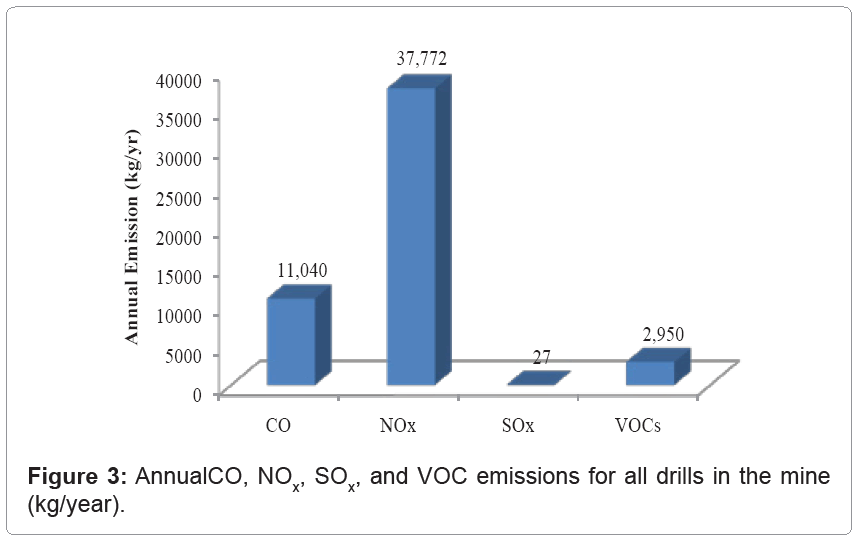Special Issue Article Open Access
Assessment of Environmental Impact of Drilling Equipment
Ali Lashgari* and Vladislav Kecojevic
Department of Mining Engineering, West Virginia University, Morgantown, West Virginia, USA
- *Corresponding Author:
- Ali Lashgari
Department of Mining Engineering
West Virginia University
Morgantown, West Virginia, USA
E-mail: ali.lashgari.65@gmail.com
Received Date: January 28, 2013; Accepted Date: January 30, 2013; Published Date: Feruary 07, 2013
Citation: Lashgari A, Kecojevic V (2013) Assessment of Environmental Impact of Drilling Equipment. J Powder Metall Min S1:007. doi: 10.4172/2168-9806.S1-007
Copyright: © 2013 Lashgari A, et al. This is an open-access article distributed under the terms of the Creative Commons Attribution License, which permits unrestricted use, distribution, and reproduction in any medium, provided the original author and source are credited.
Visit for more related articles at Journal of Powder Metallurgy & Mining
Abstract
The major environmental issues in drilling operations are related to air pollutants and sound exposure. The
environmental impact is assessed through the equipment exhaust and dust emissions, and sound pressure level. Exhaust emissions contain gases such as carbon dioxide, carbon monoxide, nitrogen oxides (NOx), sulfur oxides (SOx) and volatile organic compounds (VOCs). Dust generation is expressed through the particulate matter (PM10) and total suspended particulate matter (TSP). In this work, the modeling of environmental impact of drilling equipment was conducted using Microsoft Visual Studio. NET software. The results show that the annual fuel consumption for eight drilling machines in the mine was 1.62 million liters, hourly CO, NO NOx, SOx, and the total hourly and annual CO2 emission for all drills in the mine were determined to be 1,720 kg and 4,344,570 kg, respectively. The results of this work may be used by mining professionals to aid in quantifying environmental impact of drilling equipment.
Keywords
Drilling equipment; Environmental impact; Drilling machines; NEMS; EPPA
Introduction
The main goal in selection of drilling equipment is to maximize production rate while minimizing overall cost and environmental impact. Major environmental issues in drilling operations are related to air pollutants and sound exposure. Air pollutants include particulate matter (PM10), total suspended particulate matter (TSP), carbon dioxide (CO2), carbon moNOxide (CO), nitrogen oxides (NOx), sulfur oxides (SOx) and volatile organic compounds (VOCs).
A number of studies have been conducted to analyze emissions from mining and construction equipment. Lewis et al. [1] described governmental regulations that limit emission of air pollutants. Sharrard et al. [2] conducted research on the environmental and energy implications in the construction industry and concluded that the fuel consumption of equipment is almost twice the level indicated in various governmental reports; that the impact of air emission is 30% greater for particulate matter and almost twice the levels for NOx and VOCs. Kean et al. conducted a study to determine emissions of NOx and PM10 for off-road diesel equipment based on the diesel fuel consumption. Gautam et al. [3] used an in-field testing method to determine emission factors for diesel powered off-road engines, including excavators, frontend loaders, dozers, and street sweepers. Bogunovic and Kecojevic [4] conducted research to determine CO2 emissions of surface mining equipment. Lewis et al. [5] estimated fuel consumption, exhaust, and dust emissions of excavators, track loaders, wheel loaders, backhoes, dozers, off-road trucks, and motor graders. Frey et al. [6] used a portable emission monitoring system to gather data from excavators, backhoes, dozers, track type loaders, wheel loaders, graders, generators and off-road trucks. Dallmann and Harley [7] conducted a research to determine the exhaust emissions for NOx and fine particulate matter (PM2.5) from mobile equipment using a fuel-based methodology. Kecojevic and Komljenovic [8] determined the quantity of CO2 emitted by haul trucks and associated costs that may arise from potential CO2 legislation.
Organiscak and Reed [9] described the average and instantaneous peak dust levels 30 m from haul roads. The authors also published the results of research related to the evaluation of safe following distance for equipment in order to avoid overexposure to respirable dust from lead trucks [10].
Overexposure to sound is an important health hazard. According to Kovalchik et al. [11], many health hazards associated with mining operations have improved, with the exception of hearing loss. Excessive sound levels are detrimental to mine workers. Bolt et al. [12] established empirically-based relationships of heavy equipment sound exposure as a function of horsepower. In 1982, the Federal Highway Administration (FHWA) published a standardized construction sound model called Highway construction noise model [13]. More recently, a number of models have been developed for the prediction of sound exposure in construction projects, such as CadnaA, SoundPLAN, and the Environmental Noise Model [14]. In these models, equipment sound data is expressed as a sound pressure level at a reference distance.
The objective of this study was to assess environmental impact of drilling equipment in surface coal mining. This research is a portion of a broader project on the development of software systems for the selection of productive, cost-effective, and eco-friendly mining systems. It is sponsored by the Appalachian Research Initiatives for Environmental Sciences (ARIES).
Method
Data for this project was collected from an operating surface coal mine in West Virginia. The mine has been active since the early 1970s. Geologic formations in the mine consist of sandstone overburden, with some shale streaks, five coal seams of varying thicknesses interspersed by layers of interburden. The mine produces approximately 2.5 million tonnes of coal and about 32 million cubic meters of overburden per year.
To achieve the objectives of this research, modeling of environmental impact of drilling equipment was conducted using Microsoft Visual Studio.NET software package. The following sections provide mathematical equations that are used for determining the exhaust and dust emissions, and sound levels of the equipment.
The exhaust emission of drilling equipment (CO, NOx, SOx, VOC, and CO2) is given by equation (1)
Ei=EFi ×HFC×H (1)
Where Ei is annual emission of the substance i (kg/year); EFi is emission factor of substance i (kg/liter); HFC is hourly diesel fuel consumption (liter/hr); and H is the number of operating hours per year (hr/year). The values of emission factors were adopted from NPI [15] and EPA [16].
Dust emission is categorized according to the size range of the component particles: TSP and PM10. The TSP is the mass loading of airborne particles determined gravimetrically by a high volume air sampler. The PM10 refers to the mass loading of airborne particles that pass through a size selective inlet with a 50% efficiency cut-off at 10 μm aerodynamic diameter [17]. In other words, TSP is the total of all particles suspended in the air from loading operation. The PM10 refers to the subset of TSP, including particles smaller than 10 μm in diameter.
Dust emission from drilling operation is determined by a method given by the Environmental Protection Agency [18] and State Pollution Control Commission [19]. In this study, dust emission was determined using the following equation:
Ei=NH×EFi ×(1-CEi /100) (2)
where Ei is emission rate of pollutant i (kg/year);the NH is the number of holes drilled per year; the EFi is uncontrolled emission factor of pollutant i (kg/hole), CEi is overall control efficiency of pollutant i (%). The TSP and PM10 are pollutants i.
Various pollutant emission control technologies, such as fabric filters, electrostatic precipitators, and wet scrubbers, are usually installed on some equipment to decrease the concentration of dust emitted to air. In cases where such emission abatement tools are used, the efficiency of dust collection of the abatement device needs to be considered.
The sound pressure level is the level of sound at a measuring point. Therefore, the sound produced by the equipment should be described by specifying the measurement distance along with the sound pressure level. Sound pressure level (Lp) can be expressed as [20]:
 (3)
(3)
where p is sound pressure (Pa), and P0 is the reference sound pressure (Po = 2 × 10-5 Pa).
An alternative way to describe sound produced by a machine is the sound power level (Lw) as given in equation (4):
 (4)
(4)
where W is sound power emitted by the source (Watts) and Wo is reference sound power level (Wo=10-12Watts).
Therefore, the relation between sound pressure level and sound power level for equipment working in surface mining area can be written as:
 (5)
(5)
where Ao is reference surface which is 1 square meter and A represents the area of measuring surface which is determined as follows:
 (6)
(6)
where r is distance from the sound source.
Both sound power level and sound pressure level are defined on a logarithmic scale, called the decibel (dB). Decibels are a useful way of handling very small or very large scalar values, defined as follows:
 (7)
(7)
It is important to note that the decibels defined for sound power and sound pressure level are completely different, because the reference level for sound pressure level is P0=2×10-5 Pa while the reference level for sound power level is Wo= 10-12 Watts. It is a means for comparing two sounds and can be defined by comparing the sound level with a reference sound.
Results
Figure 1 shows an example of software module that is developed for the determination of environmental impact of a drilling machine. Since the project was completed for a North American-based company, all values in the module are presented in english units. The annual fuel consumption for eight drilling machines in the mine was calculated to be 1.62 million liters. Hourly CO, NOx, SOx, and VOCs for all drills are shown in figure 2, while the annual emissions of the various gases are shown in figure 3. The total hourly and annual CO2 emission for all drills in the mine were determined to be 1,720 kg and 4,344,570 kg, respectively.
There are many empirical models with a range of values for the cost of CO2 emission, and they are based on potential CO2 legislation. Two of the most recognized models include the U.S. Energy Information Agency’s National Energy Modeling System (NEMS) model and the Massachusetts Institute of Technology’s Emissions Prediction and Policy Analysis (EPPA) model. These models consider the cost of CO2 as ranging from $19 to $75 per tonne of CO2 emitted [21]. Assuming the minimum cost of $19 per tonne, the hourly and annual cost of CO2 emissions would be $32.68 per hour and $82,546 per year, respectfully.
Conclusions
The objective of this research was to determine environmental impact of drilling equipment in a surface coal mining operation. The approach used in this paper allowed determination of exhaust and dust emissions, and sound pressure level. Modeling of environmental impact of the equipment was conducted using Microsoft Visual Studio.NET software package. The results show that the annual fuel consumption for eight drilling machines in the mine was 1.62 million liters, hourly CO, NOx, SOx, and the total hourly and annual CO2 emission for all drills in the mine were determined to be 1,720 kg and 4,344,570 kg, respectively. The results of this work may be used by mining professionals to aid in quantifying environmental impact of drilling equipment.
Acknowledgements
The financial contribution of the Appalachian Research Initiative for Environmental Science (ARIES) is gratefully acknowledged.
References
- Lewis MP (2009) Estimating Fuel Use and Emission Rates of Non-Road Diesel Construction Equipment Performing Representative Duty Cycles. PhD thesis, North Carolina State University.
- Sharrard L, Aurora MHS, Roth M (2008) Environmental Implications of Construction Site Energy Use and Electricity Generation. ASCE, Journal of Construction Engineering and Management 133: 846-854.
- Gautam M, Carder KD, Clark NN, Lyons WD (2002) Testing for Exhaust Emissions of Diesel Powered Off-Road Engines. APB Contract 98-317. Prepared by West Virginia University for the California Air Resources Board and the California EPA, Sacramento.
- Bogunovic D, Kecojevic V (2009) Equipment CO2 Emission in Surface Coal Mining. International Journal of Mining and Mineral Engineering 1: 172-180.
- Lewis MP, Rasdorf W, Frey HC, Pang S, Kim K (2009) Requirements and Incentives for Reducing Construction Vehicle Emissions and Comparison of Nonroad Diesel Engine Emissions Data Sources. ASCE, Journal of Construction Engineering and Management 135: 341-351.
- Frey HC, Rasdorf W, Lewis P (2010) Comprehensive Field Study of Fuel Use and Emissions of Nonroad Diesel Construction Equipment. Journal of the Transportation Research Board, Transportation Research Board of the National Academies, Washington, D.C., USA.
- Dallmann RT, Harley AR (2010) Evaluation of Mobile Source Emission Trends in the United States. Journal of Geophysical Research Atmospheres 115.
- Kecojevic V, Komljenovic D (2010) Haul Truck Fuel Consumption and CO2 Emission Under Various Engine Load Conditions. SME Mining Engineering 62: 47-52.
- Organiscak AJ, Reed WMR (2004) Characteristics of Fugitive Dust Generated from Unpaved Mine Haulage Roads. International Journal of Surface Mining, Reclamation and Environment 18: 236–252.
- Reed WMR, Organiscak AJ (2005) The Evaluation of Dust Exposure to Truck Drivers Following the Lead Haul Truck. SME Annual Meeting. Salt Lake City, UT, USA.
- Kovalchik GP, Duda TF, Harper GS (2009) Technique for Estimating the Sound Power Level Radiated by Pneumatic Rock Drills and the Evaluation of a CSIR Prototype Rock Drill with Engineering Noise Controls. Journal of the Southern African Institute of Mining and Metallurgy 109: 295-299.
- Bolt, Beranek, Newman Inc. (1971) Noise from Construction Equipment and Operations, Building Equipment, and Home Appliances. U.S. Environmental Protection Agency. Office of Noise Abatement and Control, Washington, D.C, USA1.
- Bowlby W, Cohn FL (1982) Highway Construction Noise – Environmental Assessment and Abatement. Vol. 1, Executive Summary and Simplified Prediction Methods. Vanderbilt University, Nashville, TN.
- Federal Highway Administration (FHWA) (2006) Highway Construction Noise Handbook. U.S. Federal Highway Administration, Office of Natural and Human Environment, Washington, D.C. USA.
- National Pollutant Inventory (NPI) (2012) Emission Estimation Technique Manual for Mining Version 3.1.
- Environmental Protection Agency (EPA) (1985) Compilation of Air Pollutant Emission Factors. Mobile Sources. U.S. Environmental Protection Agency, Office of Transportation and Air Quality, Ann Arbor.
- National Pollutant Inventory (NPI) (1999) Emission Estimation Technique Manual for Mining and Processing of Non-Metallic Minerals.
- Environmental Protection Agency (EPA) (1998) Compilation of Air Pollutant Emission Factors, AP-42, 4th ed., United States Environmental Protection Agency, Office of Air and Radiation Office of Air Quality Planning and Standards, Research Triangle Park, North Carolina.
- SPCC (1983) Air Pollution from Coal Mining and Related Developments.
- Mollenhauer K, Tschoeke H (2010) Handbook of Diesel Engines. (1st edn), Springer-Verlag, Berlin, Germany.
- Aziz AM, Kecojevic V (2008) Carbon dioxide footprint of the U.S. mining industry and the potential costs of CO2 legislation. Mineral Resources Engineering 13: 111-129.
Relevant Topics
- Additive Manufacturing
- Coal Mining
- Colloid Chemistry
- Composite Materials Fabrication
- Compressive Strength
- Extractive Metallurgy
- Fracture Toughness
- Geological Materials
- Hydrometallurgy
- Industrial Engineering
- Materials Chemistry
- Materials Processing and Manufacturing
- Metal Casting Technology
- Metallic Materials
- Metallurgical Engineering
- Metallurgy
- Mineral Processing
- Nanomaterial
- Resource Extraction
- Rock Mechanics
- Surface Mining
Recommended Journals
Article Tools
Article Usage
- Total views: 18567
- [From(publication date):
specialissue-2013 - Apr 02, 2025] - Breakdown by view type
- HTML page views : 13877
- PDF downloads : 4690



